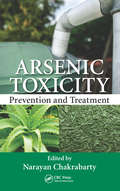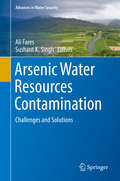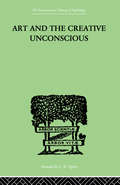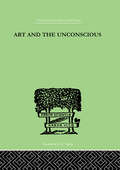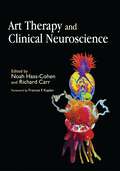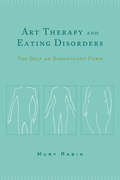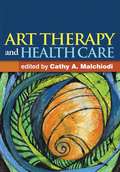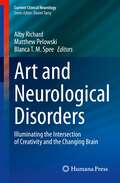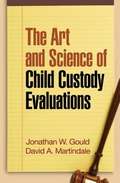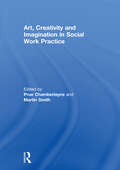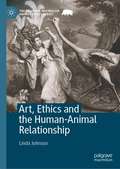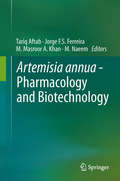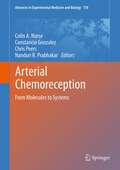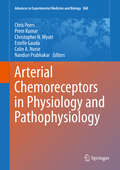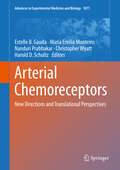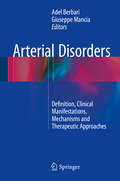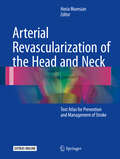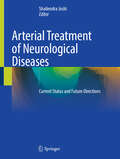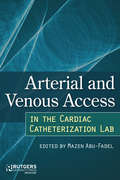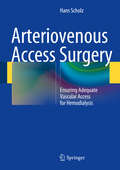- Table View
- List View
Arsenic Toxicity: Prevention and Treatment
by Narayan ChakrabartyThe most talked about metalloid in the modern world, arsenic affects the liver, kidney, and lungs; leads to cardiovascular diseases, cancer, and diabetes; and may cause blindness with long-time exposure. With naturally occurring arsenic boosted by mining and other industrial processes contaminating soil and drinking water, arsenic toxicity is a maj
Arsenic Water Resources Contamination: Challenges and Solutions (Advances in Water Security)
by Ali Fares Sushant K. SinghThis edited volume brings together a diverse group of environmental science, sustainability and health researchers to address the challenges posed by global mass poisoning caused by arsenic water contamination. The book sheds light on this global environmental issue, and proposes solutions to aquatic contamination through a multi-disciplinary lens and case studies from Bangladesh and India. The book may serve as a reference to environment and sustainability researchers, students and policy makers.Part one of the book describes the issue of arsenic contamination in ground water and river basins, including its source and distribution in specific locations in India. Part two explains the routes of exposure to environmental arsenic, its transport in aquatic ecosystems, and the health risks linked to arsenic exposure in food and the environment. Part three addresses sustainable arsenic contamination mitigation strategies and policies, the socioeconomic, demographic, cultural and psychological aspects of arsenic contamination, and the potential applications of GIS and remote sensing in providing solutions. Part four concludes by discussing the role of local and regional institutions in water resources management for a variety of issues including but not limited to arsenic contamination, and presents a case study in the Indus river basin in Pakistan to propose future contamination mitigation strategies.
Art And The Creative Unconscious: Four Essays (International Library Of Psychology Ser. #Vol. 61)
by Neumann, Erich"First Published in 1999, Routledge is an imprint of Taylor & Francis, an informa company."
Art And The Unconscious: A Psychological Approach to a Problem of Philosophy (International Library Of Psychology Ser.)
by Thorburn, John MFirst published in 1999. Routledge is an imprint of Taylor & Francis, an informa company.
Art Therapy and Clinical Neuroscience
by Noah Hass-Cohen Joanna Clyde Findlay Frances Kaplan Terre Bridgham Nicole Loya Darryl Christian Kara Wahlin Kathy Kravits Richard Carr Margarette Lathan Anne Galbraith Robin Vance Ruth Subrin Erin King-West Jessica Tress Masterson Drew RossArt Therapy and Clinical Neuroscience offers an authoritative introductory account of recent developments in clinical neuroscience and its impact on art therapy theory and practice. Contributors explore the complex relationship between art and creativity and neurological functions such as those that occur during stress response, immune functioning, child developmental phases, gender difference, the processing of imagery, attachment, and trauma. It deciphers neuroscientific language and theory and contributes innovative concrete applications and interventions useful in art therapy. This book is essential reading for art therapists, expressive arts therapists, counselors, mental health practitioners, and students.
Art Therapy and Eating Disorders: The Self as Significant Form
by Mury RabinArt Therapy and Eating Disorders is a step-by-step approach to a new and extremely promising technique for treating people with eating disorders—children as well as adults, male and female sufferers alike—that has proven to be a crucial aid to identification, prevention, and intervention. <P><P>Mury Rabin demonstrates how her award-winning art therapy technique, known as Phenomenal and Nonphenomenal Body Image Tasks or "PNBIT," can be used by clinicians other than art therapists and shows its effectiveness in combination with diverse therapeutic techniques. Unlike traditional therapy programs that treat symptoms, this technique focuses on root causes and consists of a series of tasks—some phenomenal: weight recording, mirror viewing, and body dimension estimates; others not: chromatic family line drawings and body image mandalas. The book includes five case studies that illustrate how the PNBIT technique functions in practice.
Art Therapy and Health Care
by Cathy MalchiodiDemonstrating the benefits of creative expression for patients living with acute or chronic illness, this volume provides a complete, practical introduction to medical art therapy. It presents evidence-based strategies for helping people of all ages from young children to older adults cope with physical and cognitive symptoms, reduce stress, and improve their quality of life. The book includes detailed case material and 110 illustrations. It describes ways to work with individuals and groups with specific health conditions and challenges, as well as their family members. Contributors are experienced art therapists who combine essential knowledge with in-depth clinical guidance.
Art and Neurological Disorders: Illuminating the Intersection of Creativity and the Changing Brain (Current Clinical Neurology)
by Alby Richard Matthew Pelowski Blanca T. M. SpeeThere is significant academic interest in the field of art and neurological disorders. Considering how artistic expression may be modified by alterations in neural circuits, as well as in our bodies and everyday lives, associated with a range of disorders and diseases is a rich territory from which to understand the workings of our brains, the unique blend of factors leading to human art making, and disease itself. This book will be an exposé of how different neurological disorders may influence and/or relate to the artistic process, with a particular focus on visual art and painting. The book will interrogate the question of different aspects of neurological disorders and associated brain changes that may impact artistic expression (and vice versa) and will include devoted chapters on Parkinson’s disease, Epilepsy, Mood Disorders, Autism, and Schizophrenia. Moreover, we will elaborate on the question from the perspective of the artist themselves, with chapters that highlight the artistic process in the context of lived experience (either directly or indirectly) with disease-mediated brain changes. Finally, engagement in creative acts has been linked to therapeutic benefits in multiple disease processes and neuroplasticity, which is another line of inquiry directly addressed in the book. As a whole, the volume focuses on themes and concepts at the boundary of creativity and neuroscience in such a way as to be relevant to both the medical and broader (artistic) community.
Art and Science of Child Custody Evaluations
by Jonathan Gould David MartindaleAddressing key topics in child custody evaluation, this book provides essential knowledge for practitioners who want to meet the highest standards for both scientific validity and legal admissibility. The authors are leading experts who describe the latest data-based approaches to understanding and assessing relevant child, parent, and family factors. Going beyond the basics, the book gives in-depth attention to challenging, frequently encountered issues, such as how to evaluate allegations of domestic violence, child sexual abuse, and child alienation. Also covered are the complexities of interviewing children effectively and working in the adversarial forensic context. A user-friendly appendix contains sample letters and statements of understanding, with permission to photocopy.
Art, Angst, and Trauma: Right Brain Interventions with Developmental Issues
by Doris Banowsky ArringtonArrington, a licensed clinical psychologist, brings together 15 essays on the use of art therapy with children who are seriously ill, in foster care, or physically and emotionally traumatized.
Art, Creativity and Imagination in Social Work Practice.
by Prue Chamberlayne and Martin SmithHarnessing the inspiration available from the arts and the imagination brings to life sensitive and effective social work practice. Workers feel most satisfied while service users and communities are more likely to benefit when creative thinking can be applied to practice dilemmas. Drawing on contributions from Canada, England and Utrecht this book illustrates the transforming effect of creatively applied thinking to social problems. The first part of the book considers how use of the self can be enhanced by analytic reflection and application to difficulties facing individuals and communities. The second part shows psychodynamic theory to be a valuable aid when thinking about issues faced by social workers facing threats and accusations, therapeutic work with children and restorative youth justice. The third part of the book considers the implications of working with the arts in community settings – an ex-mining community in North West England, the Tate Gallery in London and the ‘cultural capital’ of Liverpool. Taken as a whole these chapters combine to inspire and provoke thought of how the arts and the imagination can be used creativity to help service users confronted by problems with living and the workers who attempt to get alongside them to think about these.This book was published as a special issue of the Journal of Social Work Practice.
Art, Ethics and the Human-Animal Relationship (The Palgrave Macmillan Animal Ethics Series)
by Linda JohnsonThis book examines the works of major artists between the seventeenth and nineteenth centuries, as important barometers of individual and collective values toward non-human life. Once viewed as merely representational, these works can also be read as tangential or morally instrumental by way of formal analysis and critical theories. Chapter Two demonstrates the discrimination toward large and small felines in Genesis and The Book of Revelation. Chapter Three explores the cruel capture of free roaming animals and how artists depicted their furs, feathers and shells in costume as symbols of virtue and vice. Chapter Four identifies speciest beliefs between donkeys and horses. Chapter Five explores the altered Dutch kitchen spaces and disguised food animals in various culinary constructs in still life painting. Chapter Six explores the animal substances embedded in pigments. Chapter Seven examines animals in absentia-in the crafting of brushes. The book concludes with the fish paintings of William Merritt Chase whose glazing techniques demonstrate an artistic approach that honors fishes as sentient beings.
Artemisia annua - Pharmacology and Biotechnology
by Tariq Aftab Jorge F.S. Ferreira M. Masroor A. Khan M. NaeemArtemisinin, a sesquiterpene lactone originally extracted from the medicinal plant Artemisia annua L. , is an effective antimalarial agent, particularly for multi-drug resistant and cerebral malaria. However, the concentration of artemisinin in the plant is very low. Because the chemical synthesis of artemisinin is complicated and not economically feasible in view of the poor yield of the drug, the intact plant remains the only viable source of artemisinin production. Therefore, it is necessary to increase the concentration of artemisinin in A. annua to reduce the cost of artemisinin based antimalarial drugs. Plant scientists have focused their efforts on A. annua for a higher artemisinin crop yield. With the present volume, we are bringing together the research which is being done on this plant throughout the world and future possibilities for scientists and researchers who want to work on it.
Arterial Blood Gas Interpretation in Clinical Practice (In Clinical Practice)
by Anil ManeThis book is clearly structured into easy ascending steps. It starts with basic principles of physiology and then goes on to discuss topics such as hypoxia, the A-a gradient, respiratory failure, types of respiratory acidoses and their compensation. Concise and easy to follow chapters examine complex disorders of metabolic acidosis and alkalosis with examples and case reports to stimulate thoughts of the readers. Pearls of clinical wisdom are spread throughout each chapter of the book. Arterial Blood Gas Interpretation in Clinical Practice is intended for all trainees and clinicians in emergency medicine, acute medicine, intensivism, respiratory medicine, nephrology, cardiology, anaesthesia, paediatrics, internal medicine, general medicine and endocrinology. It is particularly useful to medical students and nurses working in the specialties above. Physiologists and physiotherapists working in ventilator support, will also be highly benefitted with this title.
Arterial Chemoreception: From Molecules to Systems (Advances in Experimental Medicine and Biology #758)
by Chris Peers Colin A. Nurse Constancio Gonzalez Nanduri PrabhakarArterial chemoreceptors are unique structures which continuously monitor changes in arterial blood oxygen, carbon dioxide, glucose, and acid. Alterations in these gases are almost instantaneously sensed by arterial chemoreceptors and relayed into a physiological response which restores blood homeostasis. Arterial Chemoreception contains updated material regarding the physiology of the primary arterial chemoreceptor; the carotid body. Moreover, this book also explores tantalizing evidence regarding the contribution of the aortic bodies, chromaffin cells, lung neuroepithelial bodies, and brainstem areas involved in monitoring changes in blood gases. Furthermore this collection includes data showing the critical importance of these chemoreceptors in the pathophysiology of human disease and possible therapeutic treatments. This book is a required text for any researcher in the field of arterial chemoreception for years to come. It is also a critical text for physicians searching for bench-to-bedside treatments for heart failure, sleep apnea, and pulmonary hypertension.
Arterial Chemoreceptors in Physiology and Pathophysiology (Advances in Experimental Medicine and Biology #860)
by Chris Peers Colin A. Nurse Nanduri Prabhakar Prem Kumar Christopher N. Wyatt Estelle GaudaEvery three years, the International Society for Arterial Chemoreception (ISAC) arranges a Meeting to bring together all of the major International research groups investigating the general topic of oxygen sensing in health and disease, with a prime focus upon systemic level hypoxia and carotid body function. This volume summarises the proceedings of the XIXth meeting of the Society, held in Leeds, UK during the summer of 2014. As such this volume represents a unique collection of state of the art reviews and original, brief research articles covering all aspects of oxygen sensing, ranging from the molecular mechanisms of chemotransduction in oxygen sensing cells such as the carotid body type I cells, to the adverse, reflex cardiovascular outcomes arising from carotid body dysfunction as seen, for example, in heart failure or obstructive sleep apnoea. This volume will be of tremendous interest to basic scientists with an interest in the cellular and molecular biology of oxygen sensing and integrative, whole organism physiologists as well as physicians studying or treating the clinical cardiovascular consequences of carotid body dysfunction.
Arterial Chemoreceptors: Mal(adaptive) Responses: O2 Dependent and Independent Mechanisms (Advances in Experimental Medicine and Biology #1427)
by Estelle Gauda Sílvia V. Conde Rodrigo Iturriaga Rodrigo Del Rio Emília C. MonteiroThe book will contain reviews and brief research articles from the participants attending the International Society for Arterial Chemoreception (ISAC) meeting, to be held in Lisbon in Portugal in June/July 2020. Since ISAC was first established, almost 70 years ago, many advances in the classical field of arterial O2, CO2 and pH sensing have been achieved but the most impressive ones are probably related to the non-canonical roles of the carotid body, as its involvement in sympatho-mediated diseases. Over the recent years, the carotid body field has gained attention with the findings that carotid body dysfunction is associated with the development/maintenance of highly prevalent diseases from cardio-metabolic diseases to asthma. Knowing that most of the patients with these pathologies lack long-term disease control, it is imperative to define new pathophysiological mechanisms aiming to find new therapeutic targets for treatment and prevention. This book will cover a broad range of topics related, not only with the fundamental knowledge of the mechanisms related with the chemical sensing in the carotid body, but also with the adaptive and mal-adaptive responses of arterial chemoreceptors to O2-dependent and O2-independent mechanisms, namely with their impact on respiratory, cardiovascular, and metabolic homeostasis in healthy and disease conditions. This volume will be required text for all the researchers in the field of arterial chemoreceptors and will provide a valuable reference source for years to come.
Arterial Chemoreceptors: New Directions And Translational Perspectives (Advances in Experimental Medicine and Biology #1071)
by Nanduri Prabhakar Estelle B. Gauda Maria Emilia Monteiro Christopher Wyatt Harold D. SchultzThis volume contains reviews and brief research articles from participants attending the International Society for Arterial Chemoreception meeting, to be held in the USA (July 2017). Each article contains original data and represents up-to-date information concerning the carotid body and oxygen sensing in health and disease. This volume is a required text for all researchers in the field of arterial chemoreception and will provide a valuable reference source for years to come.
Arterial Disorders: Definition, Clinical Manifestations, Mechanisms and Therapeutic Approaches
by Giuseppe Mancia Adel BerbariAs our knowledge about arterial disease is greatly expanding, the aim of this book is to explore all aspects of arterial pathology, including classification, clinical manifestations, pathogenesis, and therapeutic options. The discussion of pathophysiologic mechanisms of arterial disease is wide ranging, encompassing hemodynamic, metabolic, humoral, inflammatory, genetic and environmental factors. Particular emphasis is placed on recent concepts, such as: the role of age-associated arterial alterations in the initiation and progression of cardiovascular diseases in older persons, the importance of mineral metabolism-bone vascular interactions, the clinical and prognostic significance of the renal resistive index, retinal circulation, toxemia of pregnancy as an arterial disease, and the role of pulmonary/vascular interaction in pulmonary hypertension and cross-talk of macrocirculation and microcirculation in target organ involvement. Evaluation procedures are carefully explained, and the full range of currently available therapeutic options, including lifestyle modifications and pharmacologic approaches, are described and appraised.
Arterial Revascularization of the Head and Neck: Text Atlas for Prevention and Management of Stroke
by Horia MuresianThis book covers all aspects of the prevention, diagnosis, and treatment of stroke, offering an integrated perspective that will be relevant to a range of specialists. Extensive consideration is given to the different methods of stroke prevention and arterial revascularization, with up-to-date information on pharmacological measures and clear presentation of endovascular stent placement procedures and surgical techniques, including those involving the carotid artery, vertebral artery, and aortic arch. Complex procedures, such as simultaneous bilateral carotid revascularization, are discussed in depth, drawing on a large series of cases and setting out practical rules. The diagnosis and treatment of intra- and extracranial aneurysms and the management of cervical trauma are examined fully. In addition, the reader is provided with guidance on characterization of the culprit lesion by means of different imaging modalities and with advice on the importance of a multidisciplinary team and combined approaches (endovascular and surgical), identification of risk factors, anesthesia, neuromonitoring, and hemodynamic monitoring. The book will be of value not only for cardiac and vascular surgeons but also for cardiologists, neurologists, neurosurgeons, anesthesiologists, anatomists, specialists in diagnostic imaging, and interventional radiologists.
Arterial Stiffness: Implications and Interventions (SpringerBriefs in Physiology)
by Bradley S. Fleenor Adam J. BerronesArterial stiffness is an emerging risk factor with important implications for cardiovascular disease risk. Herein, we concisely summarize the physiological and pathophysiological aspects of arterial stiffening, and highlight the importance of increased arterial stiffness for future cardiovascular events. Factors contributing to increased arterial stiffness such as advancing age, obesity, race, sex differences and cardiorespiratory fitness are examined while elucidating the potential underlying mechanisms for each scenario. To conclude, we discuss novel interventions to prevent and/or reverse the arterial stiffening process in order to reduce cardiovascular risk. This book also: Overviews the cellular and molecular mechanisms of arterial stiffness Discusses the implications of arterial stiffness in target organ damage
Arterial Treatment of Neurological Diseases: Current Status and Future Directions
by Shailendra JoshiDrug delivery by injecting them through arteries poses unique challenges. The first attempts to treat malignant brain tumors by arterial injections were undertaken soon after World War II. Yet, the applications of arterial delivery in treating neurological diseases have not advanced significantly over the last seventy years. Although arterial drug delivery is used to treat several neurological conditions, its applications, other than for localization of brain functions, remain experimental and are unproven in robust scientific studies. Over the last two decades, interventional radiology has significantly advanced by developing catheter-based devices, but arterial drug development has largely been ignored. This book makes the case for arterial drug development. Unless drugs are developed explicitly for arterial injections, the vast potential of arterial treatments of neurological diseases will remain untapped. This multi-author book brings together experienced researchers and clinicians to investigate various applications of arterial drug delivery for treating neurological diseases. It’s an essential resource for various medical subspecialties related to the field and to advance pharmacological and clinical research with this mode of drug delivery.
Arterial and Venous Access in the Cardiac Catheterization Lab
by Faisal Latif Anas Salkini Aneesh Pakala Jose Exaire Ajay Patel Beau Hawkins Arnold Seto Fahmi Farah Dr Mazen Abu-FadelPercutaneous cardiac and endovascular procedures are performed by a variety of interventional physicians and continue to evolve and expand. One of the most important steps in performing these procedures is vascular access and their Achilles heel is vascular access site complications. This volume is intended to help the clinician by providing a practical overview of the techniques and technologies used in top catheterization laboratories to access the arterial and venous beds. Dr. Mazen Abu-Fadel and his contributors, part of the renowned cardiovascular team at the University of Oklahoma Health Sciences Center, carefully walk the reader through the various techniques used to obtain vascular access into most arterial and venous sites. They thoroughly describe current data, techniques, advantages, risks, and benefits of each vascular access site. Covering everything from anatomic landmarks to closures devices, Arterial and Venous Access in the Cardiac Catheterization Lab offers a complete overview of each procedure. In addition, it provides an up-to-date guide to the best medical technologies and equipment used when performing these procedures. Arterial and Venous Access in the Cardiac Catheterization Lab is an invaluable resource for a wide range of clinical personnel, from attending physicians and trainees to nursing staff and vascular technicians. Written by experienced leaders in the field, it demonstrates how to perform complex, risky procedures while providing patients with expert care.
Arteriovenous Access Surgery: Ensuring Adequate Vascular Access for Hemodialysis
by Hans ScholzThis book offers a comprehensive overview of up-to-date knowledge on vascular access surgery. Written by a senior author with more than 30 years of experience and by expert contributors, it covers both surgical and theoretical aspects. The author shares his expertise in a hands-on approach and presents his views on the difficulties that every clinician may encounter. The various options for vascular access creation are carefully reviewed. Detailed descriptions and numerous accompanying illustrations of AV fistulas, AV prosthetic grafts, and arterio arterial grafts are provided, and a chapter is also devoted to the use of central venous catheters. Potential complications and their management are explained, and advice is offered on how to deal with special patient groups requiring extra attention. Separate chapters on fluid dynamics (drawing on the author's own research) and vascular pathology cater for the needs of those with a particular interest in the pathophysiological principles.
Arthritis Research, Volume 2: Volume 2: Methods and Protocols (Methods in Molecular Medicine #136)
by Andrew P. CopeArthritis Research: Methods and Protocols is a compendium of data pertinent to the methods and protocols that have contributed to recent advances in molecular medicine in general, but to the molecular basis of rheumatic disease in particular. These volumes details novel technologies, some of which are still evolving and whose impacts are yet to be determined. Leaders in the field contribute to cover such exciting and cutting edge topics as imaging and immunohistochemistry, analysis of cartilage and bone catabolism, immunobiology, and cell trafficking.<P><P> In Volume 1, authors discuss synovial joint morphology, histopathology, and immunohistochemistry, cartilage matrix and bone biology, and cell trafficking, migration and invasion. Volume 2 is broken up into sections that cover immunobiology and T cells, animal models of arthritis, and applications of new technologies, such as Differential Display Reverse Transcription-Polymerase Chain Reaction (DDRT-PCR), to define novel therapeutic targets. Both volumes combine to produce a concise set of protocols condensing decades of experience and expertise.<P><P> Arthritis Research: Methods and Protocols will be a valuable tool for basic research investigators, clinician scientists, pathologists, immunologists, and biochemists looking to stay current in their fields.
